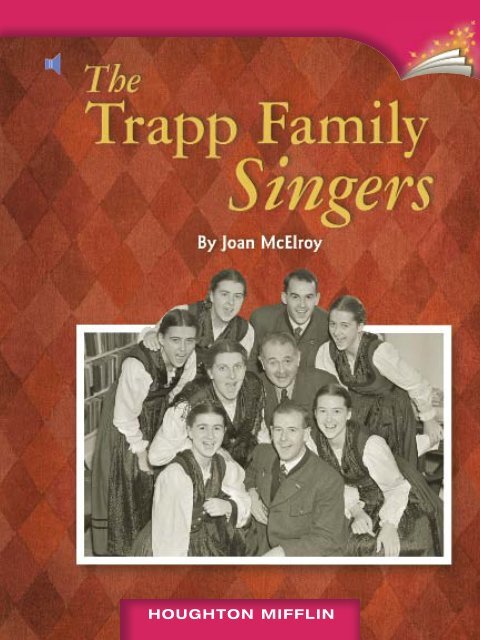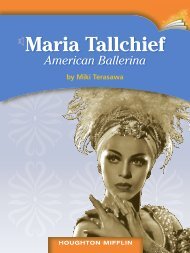Create successful ePaper yourself
Turn your PDF publications into a flip-book with our unique Google optimized e-Paper software.
HOUGHTON MIFFLIN
By Joan McElroy<br />
ILLUSTRATION CREDIT: 5 Joe LeMonnier / Melissa Turk<br />
PHOTOGRAPHY CREDITS: Cover © Bettmann / Corbis, (bkgrnd) © PhotoDisc / Museum Finishes; 1 © John Springer<br />
Collection / Corbis; 2 © PhotoDisc / Landscapes & Seascapes; 3 © Comstock / Remember When; 4 © Artville / Musical<br />
Instruments; 6–7 © PhotoDisc / Landscapes & Seascapes; 7 © Bettmann / Corbis; 8 © PhotoDisc / Festivites; 10 ©<br />
Stockbyte / Flags of the World; 12 © Corbis; 14 © PhotoDisc / Metaphors; 15 © John Springer Collection / Corbis; 17<br />
© Getty Images; 18 © PhotoDisc / Just Document; Bkgrnd © PhotoDisc / Museum Finishes, © PhotoDisc / Antique<br />
Frames<br />
Copyright © by Houghton Mifflin Harcourt Publishing Company<br />
All rights reserved. No part of this work may be reproduced or transmitted in any form or by any means, electronic or<br />
mechanical, including photocopying or recording, or by any information storage and retrieval system, without the prior<br />
written permission of the copyright owner unless such copying is expressly permitted by federal copyright law. Requests<br />
for permission to make copies of any part of the work should be addressed to Houghton Mifflin Harcourt School Publishers,<br />
Attn: Permissions, 6277 Sea Harbor Drive, Orlando, Florida 32887-6777.<br />
Printed in China<br />
ISBN-13: 978-0-547-02021-1<br />
ISBN-10: 0-547-02021-X<br />
1 2 3 4 5 6 7 8 0940 18 17 16 15 14 13 12 11<br />
If you have received these materials as examination copies free of charge, Houghton Mifflin Harcourt School Publishers<br />
retains title to the materials and they may not be resold. Resale of examination copies is strictly prohibited.<br />
Possession of this publication in print format does not entitle users to convert this publication, or any portion of it, into<br />
electronic format.
Table of Contents<br />
<strong>The</strong> <strong>Trapp</strong> <strong>Family</strong> . . . . . . . . . . . . . . . . . . . . . . . . . . . . . . . . . . . . . . 3<br />
Meet Maria Kutschera . . . . . . . . . . . . . . . . . . . . . . . . . . . . . . . . . . 6<br />
<strong>The</strong> <strong>Trapp</strong> <strong>Family</strong> <strong>Singers</strong> Are Born . . . . . . . . . . . . . . . . . . . . . . . 8<br />
Escape from the Nazis . . . . . . . . . . . . . . . . . . . . . . . . . . . . . . . . . 10<br />
Life in America . . . . . . . . . . . . . . . . . . . . . . . . . . . . . . . . . . . . . . . 14<br />
Becoming Famous. . . . . . . . . . . . . . . . . . . . . . . . . . . . . . . . . . . . . 16<br />
Real Life vs. Reel Life . . . . . . . . . . . . . . . . . . . . . . . . . . . . . . . . . . 17<br />
<strong>The</strong> <strong>Trapp</strong> <strong>Family</strong> Today . . . . . . . . . . . . . . . . . . . . . . . . . . . . . . . 18
<strong>The</strong> <strong>Trapp</strong> <strong>Family</strong><br />
<strong>The</strong> story of the <strong>Trapp</strong> <strong>Family</strong> <strong>Singers</strong> began when Georg<br />
von <strong>Trapp</strong> fell in love with Agathe Whitehead. <strong>The</strong> year was<br />
1910. Georg and Agathe both came from upper-class Austrian<br />
families. He was a talented 30-year-old naval captain. She was<br />
the granddaughter of an English inventor. Looking forward to<br />
a bright and comfortable future, the couple got married, settled<br />
down, and began to raise a family.<br />
Robert Whitehead (1823–1905)<br />
Agathe Whitehead’s grandfather, Robert, left home<br />
at the age of 14 to become an apprentice to an engineer.<br />
He worked in France and Italy before the Austrian government<br />
hired him in the 1850s. Whitehead’s task was to develop a<br />
new weapon for warships — a torpedo. Although torpedoes<br />
had been used previously, Whitehead’s was the first to be<br />
self-propelled. This innovation proved popular, and by 1881<br />
Whitehead had sold torpedoes to numerous countries,<br />
including Britain, Russia, France, Germany, and Argentina.<br />
3
Over the next ten years, Agathe and Georg had seven<br />
children — five girls and two boys. From the start, music<br />
played an important part in the family life of the <strong>Trapp</strong>s.<br />
Both Georg and Agathe played<br />
musical instruments and<br />
nurtured a love of music in<br />
their children. <strong>The</strong> family<br />
often gathered together in<br />
the evening to play music.<br />
<strong>The</strong> children learned not only to<br />
sing, but also to play several different<br />
instruments, including the piano, the<br />
guitar, the violin, and the accordion.<br />
Without knowing it, Georg and Agathe<br />
were laying the groundwork for their children’s<br />
future fame as the <strong>Trapp</strong> <strong>Family</strong> <strong>Singers</strong>. It was not a<br />
career that they dreamed of or desired for their children.<br />
Music was simply something they enjoyed and appreciated.<br />
Georg Ritter von <strong>Trapp</strong><br />
During World War I, 1914–1918, Georg von <strong>Trapp</strong><br />
was a submarine commander. He became known<br />
predominantly as the navy’s “torpedo ace” for his success<br />
in sinking enemy ships. After the war, the government gave<br />
him the title of Ritter, similar to the title of knight, and<br />
he became a national hero. He retired after World War I.<br />
4
<strong>The</strong>n tragedy struck. Agathe contracted scarlet fever.<br />
Today, scarlet fever can be controlled with antibiotics, but<br />
back then it had a tendency to turn deadly. <strong>The</strong> doctors<br />
could not save Agathe, and she died in 1922.<br />
<strong>The</strong> <strong>Trapp</strong> family home was now filled with sadness and<br />
constant reminders of the lost Agathe. Georg decided to move<br />
the family to a large new home near Salzburg, Austria. He<br />
hoped that the new surroundings would help him and the<br />
children to heal.<br />
Once there, Georg found several governesses to help<br />
take care of the children. But they could not fill the emptiness<br />
Agathe’s death created. That would change when the captain<br />
began searching for a tutor for one of his daughters and hired<br />
a young woman named Maria. In the years to come, she would<br />
not only help the family heal, but also make them famous.<br />
<strong>The</strong> <strong>Trapp</strong> family lived in Austria, a nation in central Europe.<br />
5
1936: <strong>Trapp</strong> <strong>Family</strong> wins first<br />
place at Salzburg Music Festival.<br />
1927: Georg and Maria marry.<br />
1922: Agathe dies of scarlet fever.<br />
1910: Georg<br />
von <strong>Trapp</strong> marries<br />
Agathe Whitehead.<br />
1926: Georg von<br />
<strong>Trapp</strong> hires Maria<br />
Kutschera as a tutor.<br />
1929: <strong>The</strong> Great<br />
Depression begins.<br />
Meet Maria Kutschera<br />
Maria understood what it meant to lose a parent.<br />
Her own mother died when Maria was two. Her father was<br />
more interested in traveling than raising his daughter, so he left<br />
her with elderly relatives. She grew up in a strict household, with<br />
no other children to play with and without any religious training.<br />
It was only by chance that Maria discovered religion and<br />
wound up at the convent where Captain von <strong>Trapp</strong> would find<br />
her. As the story goes, one Sunday, while she was in college,<br />
Maria decided to go to a concert. Instead, she accidentally<br />
found herself attending a Catholic service. According to Maria,<br />
she was “overwhelmed” by the service and had a religious<br />
awakening. After graduation, she went to the convent and spent<br />
6
1939: World War II starts; the <strong>Trapp</strong>s<br />
leave, then return to, the United States.<br />
1947: Georg dies.<br />
1956: <strong>Trapp</strong> <strong>Family</strong> <strong>Singers</strong><br />
hold their last concert.<br />
1965: <strong>The</strong> movie <strong>The</strong> Sound<br />
of Music is released.<br />
1987: Maria dies.<br />
1949: Maria publishes her first book.<br />
1942-1944: <strong>The</strong> <strong>Trapp</strong>s buy Vermont<br />
farm; Maria starts music center.<br />
1938: Nazis control Austria;<br />
the <strong>Trapp</strong>s flee to New York.<br />
Maria and Georg<br />
(center) made<br />
beautiful music<br />
with Georg’s<br />
seven children.<br />
7
two years preparing to become a nun. Although Maria was<br />
happy at the convent, her health suffered due to the lack<br />
of exercise and fresh air.<br />
Enter Captain Georg von <strong>Trapp</strong>. In 1926, his search for<br />
a tutor for his 12-year-old daughter brought him to Maria’s<br />
convent. <strong>The</strong> nuns thought Maria would make a good tutor.<br />
She was trained as a teacher, and they<br />
felt the change might improve her<br />
health. Maria agreed, but planned to<br />
return to the convent after 10 months.<br />
However, things didn’t work out<br />
the way she intended. Maria fell in love<br />
with all of the children, and the children and Georg fell in love<br />
with her. In 1927, Captain von <strong>Trapp</strong> asked Maria to marry him.<br />
Although Maria wasn’t sure she wanted to leave her calling as a<br />
nun, she ultimately said yes. So, at the age of 22, Maria married<br />
the 47-year-old captain and became stepmother to his seven<br />
children. Over the next four years, two more daughters were born.<br />
<strong>The</strong> <strong>Trapp</strong> <strong>Family</strong> <strong>Singers</strong> Are Born<br />
Even after Agathe’s death, Georg continued to bring<br />
the children together to sing and enjoy each other’s company.<br />
Maria also loved to sing and joined the musical gatherings.<br />
Maria taught the children new and more complex songs.<br />
Members of the family sang different parts in harmony.<br />
<strong>The</strong>y discovered that they had all the voices needed to form<br />
a choir. At that time, however, they had no thought of singing<br />
in public.<br />
8
<strong>The</strong> Great Depression<br />
<strong>The</strong> Great Depression is the worldwide economic collapse<br />
that began in 1929 and did not end until 1940. It was the<br />
longest and worst economic crisis ever experienced by industrialized<br />
countries. It began with the 1929 stock market crash in the<br />
United States. Businesses closed and banks failed, resulting in<br />
many people losing their entire life’s savings. <strong>The</strong> value of money<br />
itself decreased, and the demand for goods declined.<br />
But the Great Depression was not limited to the United<br />
States alone. <strong>The</strong> very structure of world trade collapsed, causing<br />
the value of money in other countries to decline. Europe was<br />
hit particularly hard, and millions of people there were also left<br />
unemployed.<br />
Unemployment in Europe<br />
Country 1929 1930 1931 1932 1933<br />
Austria 225,000 239,000 304,000 417,000 456,000<br />
Belgium 28,000 42,000 207,000 350,000 383,000<br />
Germany 2,484,000 3,041,000 4,744,000 6,034,000 5,599,000<br />
Sweden 44,000 42,000 73,000 99,000 121,000<br />
United<br />
Kingdom<br />
1,204,000 1,694,000 2,666,000 2,660,000 2,821,000<br />
This chart shows the number of people without jobs in several European<br />
countries during the Great Depression. Which nation had the greatest<br />
number of unemployed citizens?<br />
9
All that changed in the mid-1930s. Much of the world,<br />
including the United States, was in the midst of the Great<br />
Depression. Businesses and banks closed, and millions upon<br />
millions of men and women were out of work. Families<br />
struggled to pay the rent and to put food on the table.<br />
When the National Bank of Austria failed, Captain von<br />
<strong>Trapp</strong> lost most of his wealth. <strong>The</strong> family had to find new ways<br />
to make ends meet.<br />
Maria suggested they turn the family into a group<br />
of professional singers. Georg worried about the children<br />
becoming performers, but he reluctantly agreed. Father Wasner,<br />
a priest and family friend, became their conductor. In 1936,<br />
the <strong>Trapp</strong> <strong>Family</strong> Chorus won a competition at the Salzburg<br />
Music Festival. Soon afterwards, they were invited to perform<br />
throughout Europe.<br />
Escape from the Nazis<br />
Shortly after their new career<br />
began, the <strong>Trapp</strong> family came into<br />
conflict with a rising political power<br />
in Europe. <strong>The</strong> German people had<br />
elected Adolf Hitler as chancellor.<br />
As head of the Nazi Party, Hitler<br />
<strong>The</strong> Austrian flag<br />
began to rule as a dictator and<br />
promised to return Germany to its previous power and glory.<br />
As part of his plan, Hitler decided to take control of<br />
Germany’s neighboring countries. He led troops into Austria in<br />
1938. <strong>The</strong> Nazis took over the government and arrested many<br />
10
Austrian political leaders. Tensions rose. Captain von <strong>Trapp</strong><br />
was one of many Austrians who opposed the Nazi takeover.<br />
Most people, however, were afraid to stand up to Hitler and his<br />
brutal police force.<br />
<strong>The</strong> Nazis wanted to win Captain von <strong>Trapp</strong> over to their<br />
side because he was a war hero and torpedo expert. He could<br />
be of great use to them. So, they offered him an important<br />
command in the German navy. <strong>The</strong> oldest <strong>Trapp</strong> son wanted<br />
to be a doctor; the Nazis promised the Captain that he would<br />
get a good job. Hitler even invited the family to sing at his<br />
birthday party.<br />
Hitler’s Secret Police<br />
<strong>The</strong> police force of Nazi Germany was called the<br />
Gestapo (guh SHTAH poh). <strong>The</strong> Gestapo arrested anyone they<br />
suspected of disloyalty to their country. No one was safe from<br />
arrest. <strong>The</strong> Gestapo brutally interrogated and tortured their<br />
victims. <strong>The</strong>ir terror tactics instilled fear throughout Germany<br />
and its conquered territories. One branch of the Gestapo was<br />
responsible for deporting millions of Jews to death camps.<br />
When World War II ended, many Nazi leaders, including those<br />
from the Gestapo, were convicted as war criminals.<br />
11
Georg von <strong>Trapp</strong> refused all these honors and the money<br />
and prestige that they would bring. <strong>The</strong> <strong>Trapp</strong> family also<br />
refused to fly the Nazi flag at their home when Hitler came<br />
to Salzburg. As time went on, the family realized that they<br />
could no longer live under Hitler’s rule. <strong>The</strong> Nazis threatened<br />
the freedoms that they valued most.<br />
If the <strong>Trapp</strong>s left Austria, they likely would lose their<br />
home and remaining wealth. <strong>The</strong>y would probably never be<br />
able to return, and their friends would never see them again.<br />
<strong>The</strong>y would have only each other to rely on. In spite of these<br />
sacrifices, they knew that they had to plan their escape.<br />
Nazi police march through an Austrian city in 1938.<br />
Townspeople had to give them the Nazi salute as they passed.<br />
12
Maria managed to book a contract for a three-month<br />
concert tour in the United States. In June 1938, the <strong>Trapp</strong>s and<br />
Father Wasner boarded a train near their estate. <strong>The</strong>y took only<br />
what they could easily carry. <strong>The</strong> group traveled across the Alps<br />
to safety in Italy and then gave concerts across Europe.<br />
In September, they sailed to New York. Maria’s third child,<br />
a son, was born in Pennsylvania in January 1939.<br />
After six months, the family had to leave the United States<br />
because their visas had expired. <strong>The</strong>y made a brief concert tour<br />
through northern Europe. <strong>The</strong>n, they were able to return to<br />
New York, arriving in October 1939. By then, World War II was<br />
underway. <strong>The</strong> <strong>Trapp</strong> family had escaped just in time.<br />
<strong>The</strong> <strong>Trapp</strong> Home in Austria<br />
When the <strong>Trapp</strong>s left Austria, they wanted to sell their<br />
home to a religious order. Instead, the Nazis took it over as a<br />
headquarters for their secret police. After the war, the estate<br />
became a college for Catholic priests. Some members of the<br />
family visited their former home when they returned to the<br />
Salzburg Music Festival in 1950.<br />
13
Life in America<br />
Like many immigrants, the<br />
<strong>Trapp</strong> family had a difficult time<br />
adjusting to life in a new country.<br />
<strong>The</strong>y had to learn to speak and<br />
sing in English. <strong>The</strong>y even had to<br />
change the clothes they wore. For their<br />
first few years in America, they had no<br />
permanent home. <strong>The</strong>y lived most of the time<br />
in the bus that took them to concerts around the country.<br />
<strong>The</strong> war also brought about changes in the family<br />
singing group. <strong>The</strong> two older sons left to serve in the United<br />
States military. One son never returned to singing because he<br />
preferred to work as a doctor. <strong>The</strong> two youngest daughters<br />
joined the group when they turned 12 years old.<br />
Gradually the family’s life improved. <strong>The</strong>y gave concerts<br />
and made recordings of classical music and folk songs. To her<br />
credit, Maria hired skilled people to manage and publicize the<br />
group’s work. Over time, the <strong>Trapp</strong> <strong>Family</strong> <strong>Singers</strong> gained a<br />
wide audience.<br />
In 1942, the <strong>Trapp</strong>s purchased a farm in Stowe, Vermont.<br />
<strong>The</strong> family was thrilled to have their own home again. <strong>The</strong>y<br />
worked together to build a bigger house, plant gardens, and<br />
learn how to make maple syrup. In 1944, Maria realized her<br />
dream of starting a music center. This summer music camp was<br />
another way for the family to share its love of music and earn<br />
income at the same time.<br />
14
Maria and the children eventually became American<br />
citizens. While the <strong>Trapp</strong>s clearly loved their new country,<br />
they did not forget their homeland. Like many European<br />
nations, Austria was in terrible shape after World War II.<br />
<strong>The</strong> <strong>Trapp</strong>s established a relief fund to send hundreds of<br />
thousands of pounds of food and clothing to needy Austrians.<br />
<strong>The</strong> family’s life changed again when Captain von <strong>Trapp</strong><br />
died in 1947. After his death, the family opened a guest lodge<br />
on their Vermont farm. <strong>The</strong> lodge became — and still is —<br />
a popular tourist attraction.<br />
In 1965, the movie <strong>The</strong> Sound of Music brought the story of the <strong>Trapp</strong><br />
family to the big screen. Julie Andrews (fourth from left) played Maria,<br />
and Christopher Plummer (holding guitar) played Georg.<br />
15
<strong>The</strong> <strong>Trapp</strong> <strong>Family</strong> <strong>Singers</strong> continued to perform, but the<br />
group now included many members who were not part of the<br />
family. <strong>The</strong>ir last concerts were held in 1956. By then, many<br />
of the family members wanted to focus on other aspects of<br />
their lives. Some focused on the lodge. Others worked as dairy<br />
farmers, teachers, and missionaries.<br />
Becoming Famous<br />
Maria was considered a forceful woman who seemed to<br />
have endless energy. To help drum up singing engagements,<br />
Maria wrote her first book — <strong>The</strong> Story of the <strong>Trapp</strong> <strong>Family</strong><br />
<strong>Singers</strong>. It was published in 1949. To Maria’s surprise, the<br />
book became a bestseller. About seven years later, a German<br />
filmmaker asked Maria if he could buy the rights to the book.<br />
<strong>The</strong> family needed money at the time, so Maria sold the rights<br />
to their story for $9,000. Neither she nor the family would earn<br />
any more money from the film — or those that followed.<br />
A few years later, American producers bought the rights<br />
to the story from the Germans. <strong>The</strong> Americans turned the book<br />
into a successful Broadway musical, aptly named <strong>The</strong> Sound<br />
of Music. In 1965, the film version won an Academy Award for<br />
Best Picture. Over the years, <strong>The</strong> Sound of Music has earned<br />
hundreds of millions of dollars.<br />
<strong>The</strong> <strong>Trapp</strong> family, unfortunately, did not share in any of<br />
that money. <strong>The</strong> movie did, however, make the <strong>Trapp</strong>s famous<br />
around the world. It also turned the lodge in Vermont into a<br />
huge tourist attraction.<br />
16
Real Life vs. Reel Life<br />
<strong>The</strong> Sound of Music remains<br />
popular worldwide. Millions of<br />
people know about the <strong>Trapp</strong><br />
family from the film. <strong>The</strong> screen<br />
version doesn’t tell the exact events<br />
that happened, but it does tell a<br />
parallel story to the real-life events.<br />
For example, the movie shows<br />
the family’s escape from the Nazis<br />
shortly after Georg and Maria are<br />
married. In reality, they had been<br />
married for almost 11 years before<br />
they fled Austria. Here are some<br />
This photograph shows<br />
a scene from the movie,<br />
other discrepancies between<br />
<strong>The</strong> Sound of Music.<br />
the true story and the film:<br />
• Maria was hired as a tutor to one<br />
child, not as a governess to all of the children.<br />
• <strong>The</strong> family had 10 children, not 7.<br />
• <strong>The</strong> names and ages of the children were altered.<br />
• <strong>The</strong> <strong>Trapp</strong>s didn’t climb the Alps to escape to<br />
Switzerland. <strong>The</strong>y traveled to Italy by train before<br />
leaving for the United States.<br />
• <strong>The</strong> <strong>Trapp</strong>s’ priest was their musical director, not<br />
a musical promoter as shown in the movie.<br />
• <strong>The</strong> real-life Maria was known to have a bad temper,<br />
while the fictional Maria is always sweet.<br />
17
Finally, there was one aspect of the movie that the<br />
<strong>Trapp</strong> family was genuinely unhappy with — the portrayal<br />
of Georg. In the movie, he is strict and rather cold toward<br />
his children. His family describes him as a truly kind, warm,<br />
and gentle father, who was very concerned about the welfare<br />
of his children.<br />
<strong>The</strong> <strong>Trapp</strong> <strong>Family</strong> Today<br />
After a full life, Maria von <strong>Trapp</strong> died at the <strong>Trapp</strong> <strong>Family</strong><br />
Lodge in 1987. In 2006, six of the ten children were still living,<br />
most of them in Vermont. <strong>The</strong> family still runs the lodge, which<br />
is now a large resort and conference center. <strong>The</strong>re are also four<br />
great-grandchildren of Georg von <strong>Trapp</strong> who perform and<br />
record as <strong>The</strong> von <strong>Trapp</strong> Children.<br />
<strong>The</strong> legacy of the <strong>Trapp</strong> <strong>Family</strong> <strong>Singers</strong> lives on.<br />
<strong>The</strong>y continue to support the things they love — music,<br />
Austrian culture, and the environment. Perhaps most<br />
importantly, their story<br />
continues to inspire<br />
people. It shows what<br />
a family can do under<br />
difficult circumstances<br />
if they have courage<br />
and work together for<br />
a common goal.<br />
18
Responding<br />
TARGET SKILL Fact and Opinion What are<br />
some facts and opinions related to <strong>The</strong> <strong>Trapp</strong><br />
<strong>Family</strong> <strong>Singers</strong>? Copy the chart below. In the<br />
first column, write facts from the text. Write a<br />
related opinion in the second column.<br />
Facts<br />
<strong>The</strong> <strong>Trapp</strong> children<br />
learned to sing and<br />
play instruments.<br />
?<br />
?<br />
Opinions<br />
Families are closer<br />
when they make<br />
music together.<br />
?<br />
?<br />
Write About It<br />
Text to Self Think of an event from your life<br />
that could be a scene in a movie. Write two<br />
paragraphs telling what happens in the movie<br />
version. Since this is a fictional narrative, change<br />
some details to make the event more interesting!<br />
19
TARGET VOCABULARY<br />
aptly<br />
aspect<br />
credit<br />
genuinely<br />
innovation<br />
parallel<br />
predominantly<br />
tendency<br />
tension<br />
welfare<br />
EXPAND YOUR VOCABULARY<br />
apprentice<br />
chancellor<br />
discrepancies<br />
interrogated<br />
ultimately<br />
TARGET SKILL Fact and Opinion Decide whether<br />
an idea can be proved or is a feeling or belief.<br />
Write About It<br />
TARGET STRATEGY Summarize Briefly tell the<br />
important parts of the text in your own words.<br />
In a famous quotation, Aung San Suu Kyi said,<br />
GENRE “Please Biography use your tells freedom about to events promote in a ours.” person’s life,<br />
written What by freedoms another do person. you value most? Why? Write<br />
a letter to the editor of a Burmese newspaper<br />
explaining the freedoms you have and why they<br />
are important to you.<br />
20
Level: X<br />
DRA: 60<br />
Genre:<br />
Biography<br />
Strategy:<br />
Summarize<br />
Skill:<br />
Fact and Opinion<br />
Word Count: 2,961<br />
6.1.5<br />
HOUGHTON MIFFLIN<br />
Online Leveled Books<br />
1031882

















